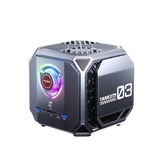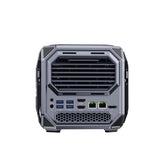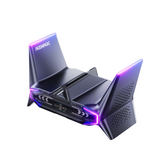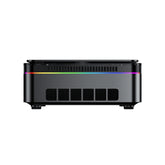Mini PC vs. Traditional Desktop: Which Is Right for You
As personal and business computing needs evolve, the question of “Mini PC vs Desktop” has become increasingly relevant. Thanks to technological advancements, the Mini PC has shed its former image as an underpowered secondary device and now serves as a compact, capable solution for light office work, media applications, and even some professional workloads.
That said, the traditional desktop computer still holds a strong position, especially when raw performance, customizability, and future-proofing are top priorities.
This guide provides an in-depth, 17-point comparison between Mini PCs and desktops—covering definitions, performance, costs, expandability, and practical use cases—so you can make a confident and informed decision based on your actual computing needs.

What Is a Mini PC? Definition and Core Characteristics
A Mini PC (Mini Personal Computer) is a desktop-class device with a dramatically reduced physical footprint. Typically no larger than a paperback book, it is designed for compactness without sacrificing essential functionality. Mini PCs can easily sit behind a monitor, on a shelf, or in a corner of a desk.
Key characteristics of Mini PCs include:
- Low power consumption, making them ideal for extended daily use.
- Highly integrated design, combining CPU, storage, and thermal management in a space-efficient layout.
- Support for major operating systems, including Windows and Linux.
- Suitability for everyday tasks, such as office software, web browsing, media streaming, and video conferencing.
Modern Mini PCs are far more powerful than earlier iterations. Many models now feature Intel’s 12th Gen Core processors or AMD Ryzen chips, support fast NVMe SSDs, and offer dual-channel memory configurations. These improvements allow Mini PCs to handle routine business tasks, multi-tab browsing, and light media editing with surprising efficiency and stability.
What Is a Traditional Desktop? Components and Core Capabilities
A traditional desktop computer is a full-sized machine built from modular components housed in a standalone case. These systems typically include a motherboard, power supply unit, CPU, RAM, storage drives, graphics card, and one or more cooling systems.
The biggest strength of desktops lies in their high degree of customization and maintainability.
Desktops offer:
- Broad hardware compatibility, allows users to mix and match components.
- Support for dedicated GPUs and multiple storage devices.
- Ease of upgrade, enabling incremental hardware improvements.
- Superior thermal design, suitable for sustained high-performance workloads.
However, this comes at a cost. Desktops are large, power-hungry, and require careful installation and cable management. They are less suited to small workspaces or mobile use cases and can be overkill for users whose needs don’t go beyond basic productivity.
Upgradability and Expandability: Can a Mini PC Meet Future Demands?
One of the most significant trade-offs when choosing a Mini PC is the limited upgrade path. Due to its compact size and integrated architecture, many Mini PCs come with components that are either soldered or not easily accessible.
In contrast, desktops are built with modular design principles, making them much easier to upgrade:
- RAM: Desktop motherboards often support four or more memory slots, while Mini PCs typically have only two.
- Storage: Desktops allow for multiple SSDs and HDDs, sometimes even RAID configurations, whereas Mini PCs often have a single M.2 slot and one 2.5-inch SATA bay.
- Graphics: Very few Mini PCs can accommodate discrete GPUs, whereas this is a standard feature in most desktop PCs.
That said, modern Mini PCs are increasingly offering modular flexibility within constraints. Some higher-end models now support replaceable RAM, dual-storage options, and even external GPU support via Thunderbolt ports, offering a partial solution for users who might scale their needs gradually.
For most users who prioritize basic upgrades like expanding RAM or switching to an SSD, a well-chosen Mini PC will be sufficient. However, if you anticipate future demands such as 4K video editing, gaming, or AI workloads, a desktop provides a better long-term value.

Power Efficiency: Which One Is More Environmentally Friendly?
Power consumption is where Mini PCs truly shine. Designed to operate with mobile-grade processors and integrated components, a typical Mini PC consumes between 15 to 45 watts under load. In contrast, desktops—especially those with high-end graphics cards—can consume 200 to 600 watts or more.
This efficiency has two major implications:
- Lower electricity bills over long periods, particularly in business environments where multiple units are used.
- Reduced environmental impact, aligning well with green IT initiatives and energy-conscious consumers.
Moreover, Mini PCs generate less heat, which translates into quieter operation and less demand on cooling systems, further enhancing their efficiency profile.
Further reading: What is TDP?
Noise and Thermal Management: Which One Runs Cooler and Quieter?
In environments like libraries, shared offices, or home studios, noise levels can be a significant concern. Mini PCs, particularly fanless models, offer near-silent operation thanks to low thermal output. Even models with fans are generally quiet due to their efficient component design and low wattage.
Desktops, on the other hand, typically rely on active cooling with multiple fans. High-performance models may even require liquid cooling systems, which can add both noise and maintenance overhead.
Additionally, desktops often produce more heat, necessitating well-ventilated cases and larger cooling solutions. This makes Mini PCs more suitable for temperature-sensitive spaces or prolonged use in closed environments.
Further reading: Liquid Cooling vs Air Cooling: Which Is Better for Your PC?
Gaming Performance: Which Suits Gamers Better?
For serious gaming, desktops maintain a clear advantage. The ability to house full-sized, dedicated graphics cards (such as NVIDIA RTX 4080 or AMD Radeon RX 7900 XTX), overclockable CPUs, and advanced cooling systems ensures high frame rates, ray tracing support, and smooth VR experiences.
Mini PCs, in comparison, cater primarily to casual or cloud gamers. While some premium Mini PCs offer integrated GPUs that can handle older or less demanding titles, they struggle with modern AAA games.
That said, with the rise of cloud gaming platforms like NVIDIA GeForce Now and Xbox Cloud Gaming, Mini PCs can serve as excellent terminals for streaming high-end games, as long as the internet connection is stable and fast.
Office Use Comparison: Light, Moderate, and Remote Work
When evaluating daily productivity tools like word processors, spreadsheets, video conferencing, and web applications, Mini PCs often meet or exceed expectations. Their fast boot times, low noise, and minimal footprint make them ideal for modern, clutter-free workspaces.
For light and moderate office tasks:
- Mini PCs are cost-effective, energy-efficient, and compact.
- Remote workers benefit from portability and ease of setup.
In contrast, desktops provide superior multitasking power and are better suited for demanding enterprise workloads like software development, virtual machines, or large-scale databases. In such cases, the performance headroom of a desktop can reduce latency and increase efficiency.
Further reading: How to Maintain and Extend the Lifespan of Your Mini PC?

Multimedia and Creative Work: Which One Handles the Load Better?
Video editing, photo processing, music production, and 3D modeling are resource-intensive tasks that push CPUs, GPUs, and storage systems to their limits. Desktop PCs, with their ability to support dedicated GPUs, higher RAM capacities, and faster drives, are generally the preferred choice for professionals in creative industries.
Mini PCs, however, are closing the gap for light to moderate content creation. Many now come with integrated graphics that support 4K video playback and basic editing in applications like Adobe Premiere Rush or DaVinci Resolve.
While they’re not replacements for full-fledged workstations, they are increasingly viable for entry-level creators, educators, and content teams working in constrained spaces.

Cost Analysis: Purchase, Maintenance, and Upgrade Costs
Cost considerations vary depending on your long-term goals.
| Cost Category | Mini PC | Desktop PC |
|---|---|---|
| Initial Cost | Lower (from $200) | Mid to High (from $400) |
| Maintenance | Minimal | Moderate to High |
| Upgrade Costs | Limited, low-cost | Higher due to parts |
| Lifespan ROI | High in short-term | Higher in long-term |
While desktops provide more upgrade flexibility, they often require additional investment over time. Mini PCs offer lower entry points and are easier to replace entirely when technology advances, which can simplify budgeting for both individuals and IT departments.
Space and Aesthetics: Optimizing Desk Real Estate
Mini PCs are a natural fit for modern minimalist setups. Their ability to be mounted behind a monitor, under a desk, or even on a wall keeps the workspace clean and distraction-free.
Desktops, while functional, often dominate the workspace. Their bulk, wiring, and peripheral needs can interrupt the flow of an otherwise streamlined environment.
For businesses looking to maximize usable space or individuals creating a minimalist aesthetic, Mini PCs deliver a strong advantage.
Portability: The Right Choice for Mobile Setups
Mini PCs can easily be moved between home and office, packed into a backpack, or even taken on business trips. Some models come with carrying kits or VESA mount options for quick reinstallation.
Desktops, due to size and weight, are not designed for frequent relocation. Even small form-factor desktops require disassembly and careful transport.

Setup and Cable Management: Simplicity vs Complexity
Mini PCs are often "plug-and-play" systems. With integrated Wi-Fi, Bluetooth, and minimal cabling, setting them up takes just minutes.
Desktops may need:
- Multiple power cables
- Monitor and graphics cables
- External peripherals and cooling attachments
This can be overwhelming for first-time users or those unfamiliar with hardware installation.
Longevity and Reliability: Durability in the Long Run
Mini PCs, built with fewer moving parts and optimized for low heat, tend to experience fewer mechanical failures. However, their closed design makes internal repairs or part replacements difficult, which may lead to a shorter effective lifespan for power users.
Desktops excel here due to modularity. Faulty components can be replaced individually, extending the device's overall life.
In professional IT environments, this makes desktops easier to maintain at scale, though Mini PCs reduce complexity and physical management overhead.
User Recommendations: Which Device Suits Your Needs?
| User Profile | Recommended Option |
|---|---|
| General Home User | Mini PC |
| Business Office Worker | Mini PC or Desktop (depends on load) |
| Gamer | Desktop |
| Creative Professional | Desktop |
| Student | Mini PC |
| Remote Worker | Mini PC |
| IT System Admin | Desktop (for scalability) |
Mini PCs are ideal for most users who prioritize space, power efficiency, and modern connectivity. Desktops remain best for those needing raw power or full customization.
Comparison Summary: Mini PC vs Desktop
| Criteria | Mini PC | Desktop |
|---|---|---|
| Size and Portability | Excellent | Poor |
| Performance | Moderate | High |
| Upgrade Potential | Limited | Extensive |
| Power Consumption | Low | High |
| Gaming Capabilities | Basic or Cloud-only | Excellent |
| Price Efficiency | High | Moderate |
| Office Use | Great | Great (for power users) |
| Creative Work | Adequate (entry) | Best-in-class |
| Maintenance | Low | Moderate to High |
Conclusion: Choosing Based on Practical Needs
Choosing between a Mini PC and a Desktop isn't about finding the “better” device—it’s about identifying the right tool for the job.
If your priorities are space-saving, energy efficiency, low noise, and cost-effectiveness, then a modern Mini PC is an excellent choice for most home users, remote workers, and even small businesses.
However, if your workflow involves heavy processing, gaming, or creative tasks, a traditional Desktop still holds the performance crown, offering flexibility and long-term scalability.
Ultimately, a well-informed decision begins with a clear understanding of your usage scenario—now you have the knowledge to make that decision wisely.
FAQ about Mini PC vs Desktop
What Distinguishes a Mini PC From a Traditional Desktop?
A Mini PC is significantly smaller and more compact than a traditional desktop. While desktops offer greater performance potential and expandability, Mini PCs prioritize space efficiency, power savings, and quiet operation. They are typically built with integrated components and mobile-grade processors, making them ideal for non-intensive, daily computing tasks in limited spaces.
Are Mini PCs powerful enough for everyday office tasks?
Yes, today’s Mini PCs are more than capable of handling office software, email, web-based platforms, virtual meetings, and even multitasking across multiple applications. Many use modern Intel Core or AMD Ryzen processors and fast SSDs, providing smooth performance for professional environments.
Can a Mini PC replace a desktop for business use?
In most standard business scenarios—such as word processing, ERP access, video conferencing, or CRM platforms—a Mini PC performs excellently. It also reduces electricity consumption, clutter, and noise. However, industries requiring GPU acceleration or highly customizable systems may still benefit from desktops.
Is a Mini PC suitable for gaming?
Mini PCs are not built for high-end gaming. While they can handle light gaming or browser-based titles, most lack the discrete GPUs necessary for running modern AAA games. That said, cloud gaming services and external GPU solutions are making Mini PCs increasingly gaming-capable.
How long can I expect a Mini PC to last?
Most Mini PCs have a lifespan of 5–7 years, especially when used within recommended workloads. They tend to be reliable due to low heat output and few moving parts, though their limited upgrade options may necessitate full replacement rather than component swaps.
Can I upgrade components in a Mini PC?
Yes, but within limits. Common upgrades include RAM and storage—some models allow dual SSD configurations or increased memory capacity. CPU and GPU upgrades, however, are generally not feasible due to their soldered or tightly integrated nature.
Which is more cost-effective in the long run: Mini PC or Desktop?
Mini PCs are more cost-effective for users with consistent, light-to-moderate workloads. They offer lower upfront prices and lower energy bills. Desktops, while more expensive initially, may offer better long-term value for users who plan to upgrade incrementally rather than replace whole systems.
Are Mini PCs secure enough for business environments?
Yes. Many Mini PCs support enterprise-grade security features like TPM (Trusted Platform Module), secure boot, BitLocker encryption, and BIOS-level password protection. These features make them a viable option for businesses prioritizing data security, especially in remote or hybrid work settings.
Do Mini PCs support dual or triple monitor setups?
Many modern Mini PCs support dual-monitor output, and some even support three displays depending on the available ports (HDMI, DisplayPort, USB-C). This makes them perfectly suitable for multitasking, stock trading, and extended desktop environments in professional settings.







Leave a comment
Please note, comments need to be approved before they are published.